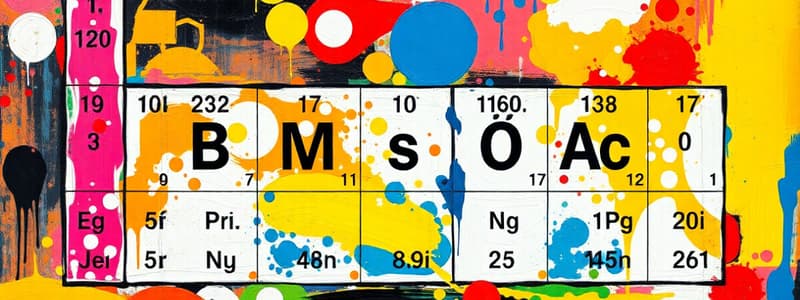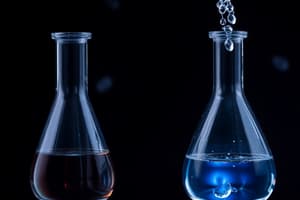Podcast
Questions and Answers
Which of the following gases contains one carbon atom and two oxygen atoms?
Which of the following gases contains one carbon atom and two oxygen atoms?
- Ammonia
- Water
- Oxygen
- Carbon Dioxide (correct)
Low density and being a thermal conductor are properties of Iron.
Low density and being a thermal conductor are properties of Iron.
False (B)
What are the molecules present in water?
What are the molecules present in water?
$H_2O$
The gas that is commonly used for balloons is ______.
The gas that is commonly used for balloons is ______.
Match the following elements with their corresponding properties or common uses:
Match the following elements with their corresponding properties or common uses:
Which method is commonly used to separate iron objects from a mixture?
Which method is commonly used to separate iron objects from a mixture?
A mixture consists of substances that are chemically bonded together.
A mixture consists of substances that are chemically bonded together.
What is the primary process used to separate liquids with different boiling points?
What is the primary process used to separate liquids with different boiling points?
In ___________, a liquid solution is allowed to evaporate, leaving solid components behind.
In ___________, a liquid solution is allowed to evaporate, leaving solid components behind.
Match the following terms to their definitions:
Match the following terms to their definitions:
What is an element?
What is an element?
A compound can be made up of atoms of the same element.
A compound can be made up of atoms of the same element.
What type of mixture is a solution?
What type of mixture is a solution?
A molecule is formed when two or more atoms are held together by __________.
A molecule is formed when two or more atoms are held together by __________.
Match the following terms with their definitions:
Match the following terms with their definitions:
Which of the following is NOT a method used to separate mixtures?
Which of the following is NOT a method used to separate mixtures?
In a heterogeneous mixture, the different parts are usually not visible.
In a heterogeneous mixture, the different parts are usually not visible.
What charge does the nucleus of an atom have?
What charge does the nucleus of an atom have?
Which of the following characteristics describes copper?
Which of the following characteristics describes copper?
Sulfur is a good conductor of electricity.
Sulfur is a good conductor of electricity.
What is the primary difference between H₂O and H₂O₂?
What is the primary difference between H₂O and H₂O₂?
Honey is classified as a __________ mixture.
Honey is classified as a __________ mixture.
Match the following mixtures with their classification:
Match the following mixtures with their classification:
Flashcards are hidden until you start studying
Study Notes
Elements and Compounds
- Elements are substances that cannot be broken down into other substances.
- Each element has specific physical and chemical properties.
- Elements are represented by one- or two-letter symbols.
- Atoms of elements can combine to form molecules.
- A molecule can be made of atoms of different elements or atoms of the same element.
- A compound is made of two or more elements chemically combined in a set ratio.
- Compounds have different properties from the elements they are made of.
Mixtures
- Mixtures are made of two or more substances that are together but not chemically combined.
- Each substance in a mixture keeps its own properties.
- Mixtures can be heterogeneous or homogeneous.
- Heterogeneous mixtures have visible parts that can be easily separated.
- Homogeneous mixtures have substances evenly mixed and are difficult to separate.
- Solutions are homogeneous mixtures.
Separating Mixtures
- Magnetic attraction separates iron objects.
- Evaporation separates liquids from solids by leaving a liquid to evaporate.
- Filtration separates solids from liquids using a filter.
- Distillation separates liquids by boiling them into a gas and then condensing the gas.
Atoms and Molecules
- Atoms make up all elements.
- Atoms have a positively charged nucleus surrounded by a negatively charged cloud.
- Molecules are groups of two or more atoms held together by chemical bonds.
- Chemical bonds are forces of attraction between atoms.
Examples of Mixtures
- Honey is a homogeneous mixture.
- Guacamole is a heterogeneous mixture.
- Soy sauce is a homogeneous mixture.
- Ketchup is a homogeneous mixture.
Chemical Bonds
- Chemical bonds hold atoms together.
- The ratio of carbon to oxygen in carbon dioxide is 12:11.
- H₂O₂ (hydrogen peroxide) has an extra oxygen atom compared to H₂O (water), making them different.
Elements Examples
- Copper is malleable, ductile, an alloy, non-magnetic, conductive and has a melting point.
- Sulfur is a colorless, brittle, light yellow solid, a poor conductor of electricity.
Compounds Examples
- Copper sulfide has electrical conductivity, hardness, density, a molar mass, a melting point, and solubility in water.
Studying That Suits You
Use AI to generate personalized quizzes and flashcards to suit your learning preferences.




